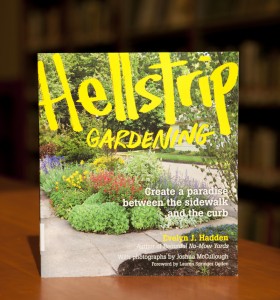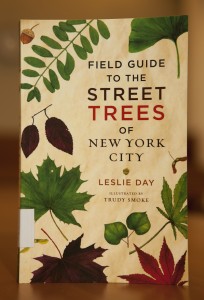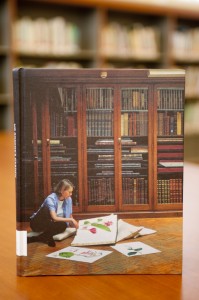Inside The New York Botanical Garden
Posted in From the Library on August 4 2014, by Mia D'Avanza
Mia D’Avanza is a Reference Librarian/Exhibitions Coordinator for The LuEsther T. Mertz Library.
 There are other words that you can use to describe the piece of land between the street and the sidewalk—“tree park” or “meridian” are a couple of them—but of those synonyms, “hellstrip” is my favorite by far.
There are other words that you can use to describe the piece of land between the street and the sidewalk—“tree park” or “meridian” are a couple of them—but of those synonyms, “hellstrip” is my favorite by far.
Thanks to Evelyn J. Hadden’s instructive book, Hellstrip Gardening, I can now use that term with aplomb. Where you or I might see a neglected, soil-filled curbside, Hadden sees colorful, even edible, planting opportunities. Her photo-rich book is organized into four parts, including inspirational curbside gardens around the country, the challenges of planting and maintaining these nontraditional spaces, suggestions for appropriate plants, and how to design and keep up with the needs of your new plot.
Hellstrip Gardening manages to combine the promises of community beautification and the psychological benefits of having nature close at hand with practical and clear-eyed advice. Hadden does not pretend that you will simply plant your hellstrip and it will be appreciated by all, remaining untouched by pedestrians, dogs, rodents, restrictive city or community laws, or road work. Instead, she outlines the realities of planting in semi-public or public spaces and how to approach this kind of gardening with reasonable expectations. Her refreshing and upbeat book is a good choice for anyone who is patient and looking for creative opportunities to establish beauty where others see blight.
Hellstrip Gardening: Create a Paradise Between the Sidewalk and the Curb by Evelyn J. Hadden, Portland, Or.: Timber Press, 2014
Posted in From the Library on October 4 2012, by Matt Newman
Mia D’Avanza is a Reference Librarian for The LuEsther T. Mertz Library.
 Because the Mertz Library is open to the public, we serve a wide variety of patrons, from second graders learning the many parts of a flower, to NYBG scientists conducting rigorous botanical research. Field Guide to the Street Trees of New York City lands squarely in the middle of that spectrum. Serving as a focused complement to Leslie Day’s previous work, Field Guide to the Natural World of New York City, this beautifully illustrated and photo-heavy book is full of helpful information for anyone who has ever wondered what kinds of trees shade the city.
Because the Mertz Library is open to the public, we serve a wide variety of patrons, from second graders learning the many parts of a flower, to NYBG scientists conducting rigorous botanical research. Field Guide to the Street Trees of New York City lands squarely in the middle of that spectrum. Serving as a focused complement to Leslie Day’s previous work, Field Guide to the Natural World of New York City, this beautifully illustrated and photo-heavy book is full of helpful information for anyone who has ever wondered what kinds of trees shade the city.
As a thorough guide, the book even provides the addresses of places in each of the five boroughs where you can view a live example of each profiled tree. I grabbed it off of the shelf with the idea of identifying a large tree I’d seen at the top of Marcus Garvey Park, near the historic Fire Tower; I was quickly able to identify the tree I’d seen as the London Plane (Platanus x acerifolia), NYC’s most common tree and a regular at the NYBG. You’ll know it by its large, spiked “seed balls” and almost mottled bark.
Read More
Posted in From the Library on April 25 2012, by Matt Newman
 Not many can recall the Liverpool Botanic Gardens. Though its glasshouse and extensive collection of orchids saw thousands of visitors pass through in the early decades of their existence, the middle years of the twentieth century were not kind. After over a century of high regard, the 1930s and ’40s brought the second World War, along with an errant German bomb that destroyed much of the botanic glasshouse and its contents. A decade-long effort to rebuild the architecture on a post-war budget proved shoddy, and within 15 years the replacement structure had fallen into disrepair. By the rapid decline of the 1970s, the glasshouse’s rotting wooden framework and broken glass panes had become emblematic of Liverpool’s floundering economy.
Not many can recall the Liverpool Botanic Gardens. Though its glasshouse and extensive collection of orchids saw thousands of visitors pass through in the early decades of their existence, the middle years of the twentieth century were not kind. After over a century of high regard, the 1930s and ’40s brought the second World War, along with an errant German bomb that destroyed much of the botanic glasshouse and its contents. A decade-long effort to rebuild the architecture on a post-war budget proved shoddy, and within 15 years the replacement structure had fallen into disrepair. By the rapid decline of the 1970s, the glasshouse’s rotting wooden framework and broken glass panes had become emblematic of Liverpool’s floundering economy.
The Gardens closed without ceremony in 1984. With an unresolved labor dispute muddying the ground between the city council and the botanical workforce, Liverpool’s decision to shutter the space was labeled an act of political spite. What remained of the LBG’s extensive plant collection–now orphaned–was moved off-grounds. And, to some, the untold beauty and presence of a world-renowned paradise of exotic plants was lost to time.
Read More
 There are other words that you can use to describe the piece of land between the street and the sidewalk—“tree park” or “meridian” are a couple of them—but of those synonyms, “hellstrip” is my favorite by far.
There are other words that you can use to describe the piece of land between the street and the sidewalk—“tree park” or “meridian” are a couple of them—but of those synonyms, “hellstrip” is my favorite by far.

